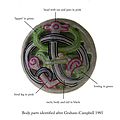File:Early Medieval Brooch (FindID 428357).jpg

Original file (3,720 × 2,076 pixels, file size: 1.79 MB, MIME type: image/jpeg)
Captions
Captions
Summary
[edit]| Early Medieval Brooch | |||
|---|---|---|---|
| Photographer |
West Yorkshire Archaeology Advisory Service, carole bloom, 2011-02-10 16:19:10 |
||
| Title |
Early Medieval Brooch |
||
| Description |
English: A copper alloy brooch decorated in a fusion of the Borre and Jellinge styles, possibly a Viking import, dating from 900-950 AD. The brooch is domed and in two parts; a flat backplate and a slightly domed, openwork front. The reverse carries the remains of a double mount for a hinged pin and a catch plate, together with an additional lug at right angles to the pin, which was probably perforated, but is also broken. The hinge and pin are also missing. The openwork upper portion is made up of a single profile beast with a thin, intertwined body, making a roughly triangular shape and with the hind leg gripping the foreleg. This body has a narrow groove or contour line running along each side for the full length of the beast. There is a central copper alloy rivet holding the two sections of the brooch together. There is no visible evidence of gilding: the brooch displays a dark brown patina. It is 32.1mm in diameter and 9.9mm thick. It weighs 13.32g.
These brooches have been the subject of studies by Ingmar Jansson (1984), James Graham-Campbell (1985) and Jane Kershaw (2009). They come in two variants, of composite construction (as here) and of one-piece construction. In 1985 they were concentrated in Scandinavia, leading Graham-Campbell to suggest an East Scandinavian origin; by 2009 eleven were known from Britain. Another composite example can be found on the database at NCL-7E9EE5. An example of the type with one-piece construction can be found on the database at reference CAM-371E87. |
||
| Depicted place | (County of findspot) Lincolnshire | ||
| Date | between 900 and 950 | ||
| Accession number |
FindID: 428357 Old ref: SWYOR-114BB0 Filename: PAS_1386_brooch.jpg |
||
| Credit line |
|
||
| Source |
https://finds.org.uk/database/ajax/download/id/316221 Catalog: https://finds.org.uk/database/images/image/id/316221/recordtype/artefacts archive copy at the Wayback Machine Artefact: https://finds.org.uk/database/artefacts/record/id/428357 |
||
| Permission (Reusing this file) |
Attribution-ShareAlike License | ||
| Other versions |
|
||
| Object location | 53° 18′ 44.64″ N, 0° 23′ 57.04″ W | View this and other nearby images on: OpenStreetMap |
|---|
Licensing
[edit]- You are free:
- to share – to copy, distribute and transmit the work
- to remix – to adapt the work
- Under the following conditions:
- attribution – You must give appropriate credit, provide a link to the license, and indicate if changes were made. You may do so in any reasonable manner, but not in any way that suggests the licensor endorses you or your use.
- share alike – If you remix, transform, or build upon the material, you must distribute your contributions under the same or compatible license as the original.
File history
Click on a date/time to view the file as it appeared at that time.
| Date/Time | Thumbnail | Dimensions | User | Comment | |
|---|---|---|---|---|---|
| current | 22:55, 5 February 2017 |  | 3,720 × 2,076 (1.79 MB) | Fæ (talk | contribs) | Portable Antiquities Scheme, SWYOR, FindID: 428357, early medieval, page 8907, batch primary count 80721 |
You cannot overwrite this file.
File usage on Commons
The following 2 pages use this file:
Metadata
This file contains additional information such as Exif metadata which may have been added by the digital camera, scanner, or software program used to create or digitize it. If the file has been modified from its original state, some details such as the timestamp may not fully reflect those of the original file. The timestamp is only as accurate as the clock in the camera, and it may be completely wrong.
| Orientation | Normal |
|---|---|
| Horizontal resolution | 72 dpi |
| Vertical resolution | 72 dpi |
| Software used | Adobe Photoshop Elements 2.0 |
| File change date and time | 19:35, 8 February 2011 |
| Color space | Uncalibrated |

